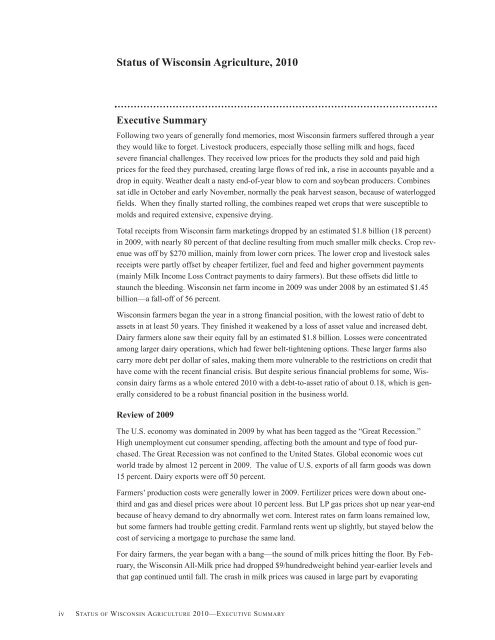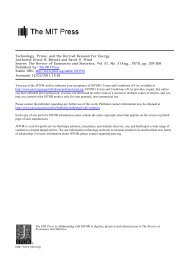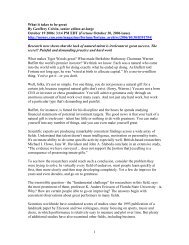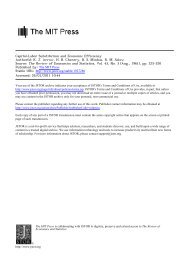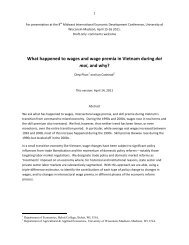Status of Wisconsin Agriculture 2010 - Agricultural & Applied ...
Status of Wisconsin Agriculture 2010 - Agricultural & Applied ...
Status of Wisconsin Agriculture 2010 - Agricultural & Applied ...
Create successful ePaper yourself
Turn your PDF publications into a flip-book with our unique Google optimized e-Paper software.
<strong>Status</strong> <strong>of</strong> <strong>Wisconsin</strong> <strong>Agriculture</strong>, <strong>2010</strong><br />
Executive Summary<br />
Following two years <strong>of</strong> generally fond memories, most <strong>Wisconsin</strong> farmers suffered through a year<br />
they would like to forget. Livestock producers, especially those selling milk and hogs, faced<br />
severe financial challenges. They received low prices for the products they sold and paid high<br />
prices for the feed they purchased, creating large flows <strong>of</strong> red ink, a rise in accounts payable and a<br />
drop in equity. Weather dealt a nasty end-<strong>of</strong>-year blow to corn and soybean producers. Combines<br />
sat idle in October and early November, normally the peak harvest season, because <strong>of</strong> waterlogged<br />
fields. When they finally started rolling, the combines reaped wet crops that were susceptible to<br />
molds and required extensive, expensive drying.<br />
Total receipts from <strong>Wisconsin</strong> farm marketings dropped by an estimated $1.8 billion (18 percent)<br />
in 2009, with nearly 80 percent <strong>of</strong> that decline resulting from much smaller milk checks. Crop revenue<br />
was <strong>of</strong>f by $270 million, mainly from lower corn prices. The lower crop and livestock sales<br />
receipts were partly <strong>of</strong>fset by cheaper fertilizer, fuel and feed and higher government payments<br />
(mainly Milk Income Loss Contract payments to dairy farmers). But these <strong>of</strong>fsets did little to<br />
staunch the bleeding. <strong>Wisconsin</strong> net farm income in 2009 was under 2008 by an estimated $1.45<br />
billion—a fall-<strong>of</strong>f <strong>of</strong> 56 percent.<br />
<strong>Wisconsin</strong> farmers began the year in a strong financial position, with the lowest ratio <strong>of</strong> debt to<br />
assets in at least 50 years. They finished it weakened by a loss <strong>of</strong> asset value and increased debt.<br />
Dairy farmers alone saw their equity fall by an estimated $1.8 billion. Losses were concentrated<br />
among larger dairy operations, which had fewer belt-tightening options. These larger farms also<br />
carry more debt per dollar <strong>of</strong> sales, making them more vulnerable to the restrictions on credit that<br />
have come with the recent financial crisis. But despite serious financial problems for some, <strong>Wisconsin</strong><br />
dairy farms as a whole entered <strong>2010</strong> with a debt-to-asset ratio <strong>of</strong> about 0.18, which is generally<br />
considered to be a robust financial position in the business world.<br />
Review <strong>of</strong> 2009<br />
The U.S. economy was dominated in 2009 by what has been tagged as the “Great Recession.”<br />
High unemployment cut consumer spending, affecting both the amount and type <strong>of</strong> food purchased.<br />
The Great Recession was not confined to the United States. Global economic woes cut<br />
world trade by almost 12 percent in 2009. The value <strong>of</strong> U.S. exports <strong>of</strong> all farm goods was down<br />
15 percent. Dairy exports were <strong>of</strong>f 50 percent.<br />
Farmers’ production costs were generally lower in 2009. Fertilizer prices were down about onethird<br />
and gas and diesel prices were about 10 percent less. But LP gas prices shot up near year-end<br />
because <strong>of</strong> heavy demand to dry abnormally wet corn. Interest rates on farm loans remained low,<br />
but some farmers had trouble getting credit. Farmland rents went up slightly, but stayed below the<br />
cost <strong>of</strong> servicing a mortgage to purchase the same land.<br />
For dairy farmers, the year began with a bang—the sound <strong>of</strong> milk prices hitting the floor. By February,<br />
the <strong>Wisconsin</strong> All-Milk price had dropped $9/hundredweight behind year-earlier levels and<br />
that gap continued until fall. The crash in milk prices was caused in large part by evaporating<br />
iv STATUS OF WISCONSIN AGRICULTURE <strong>2010</strong>—EXECUTIVE SUMMARY


